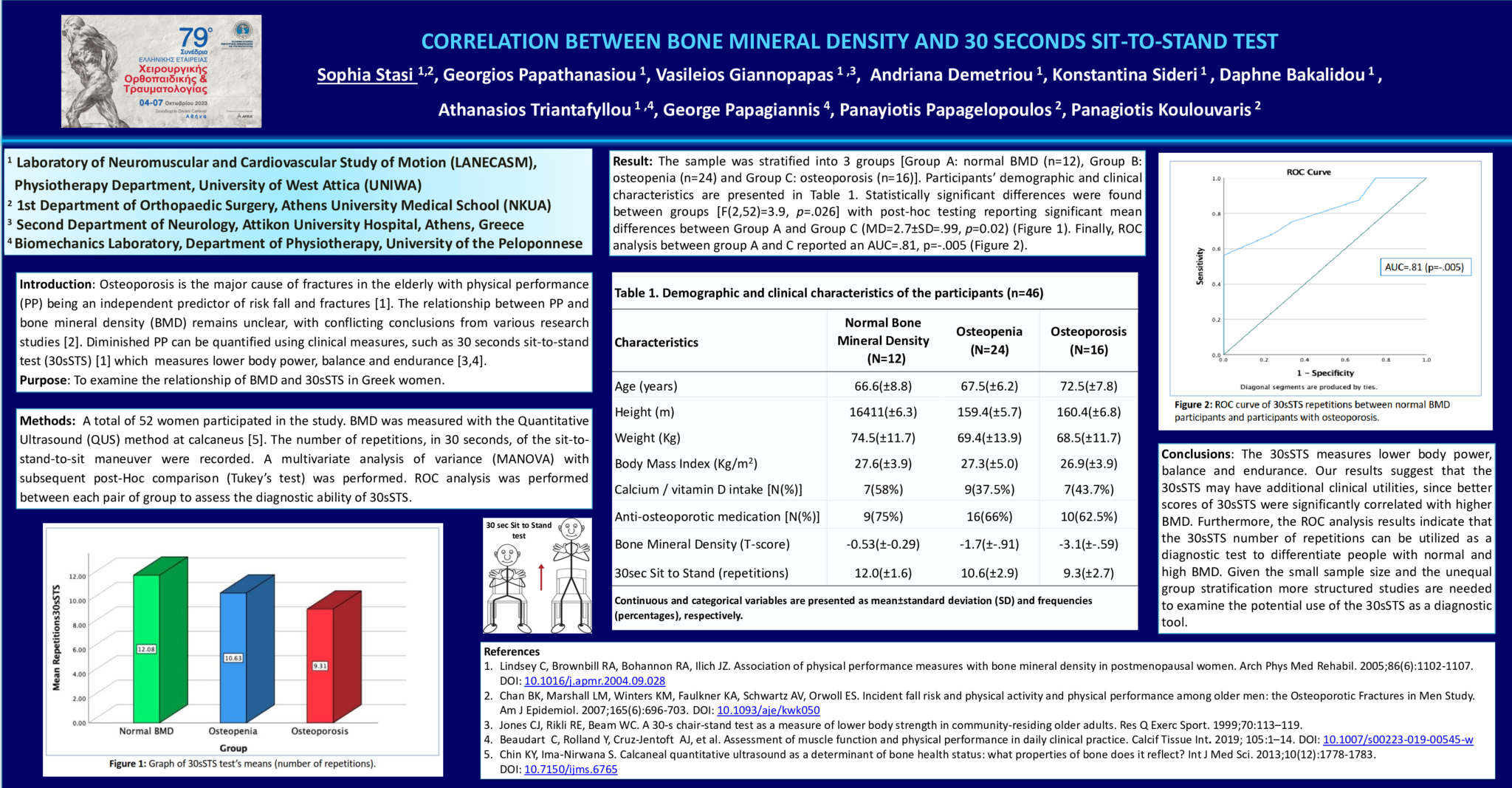ABSTRACT
Introduction: Osteoporosis is the major cause of fractures in the elderly with physical performance (PP) being an independent predictor of risk fall and fractures.1 The relationship between PP and bone mineral density (BMD) remains unclear, with conflicting conclusions from various research studies.2 Diminished PP can be quantified using clinical measures, such as 30 seconds sit-to-stand test (30sSTS)1 which measures lower body power, balance and endurance.3,4
Purpose: To examine the relationship of BMD and 30sSTS in Greek women
Methods: A total of 52 women participated in the study. BMD was measured with the Quantitative Ultrasound (QUS) method at calcaneus.5 The number of repetitions, in 30 seconds, of the sit-to-stand-to-sit maneuver were recorded. A multivariate analysis of variance (MANOVA) with subsequent post-Hoc comparison (Tukey’s test) was performed. ROC analysis was performed between each pair of group to assess the diagnostic ability of 30sSTS.
Results: The sample was stratified into 3 groups [Group A: normal BMD (n=12), Group B: osteopenia (n=24) and Group C: osteoporosis (n=16)]. Participants’ demographic and clinical characteristics are presented in Table 1. Statistically significant differences were found between groups [F(2,52)=3.9, p=.026] with post-hoc testing reporting significant mean differences between Group A and Group C (MD=2.7±SD=.99, p=0.02) (Figure 1). Finally, ROC analysis between group A and C reported an AUC=.81, p=-.005 (Figure 2)
Conclusions
The 30sSTS measures lower body power, balance and endurance. Our results suggest that the 30sSTS may have additional clinical utilities, since better scores of 30sSTS were significantly correlated with higher BMD. Furthermore, the ROC analysis results indicate that the 30sSTS number of repetitions can be utilized as a diagnostic test to differentiate people with normal and high BMD. Given the small sample size and the unequal group stratification more structured studies are needed to examine the potential use of the 30sSTS as a diagnostic tool.
References
- Lindsey C, Brownbill RA, Bohannon RA, Ilich JZ. Association of physical performance measures with bone mineral density in postmenopausal women. Arch Phys Med Rehabil. 2005;86(6):1102-1107. DOI: 10.1016/j.apmr.2004.09.028
- Chan BK, Marshall LM, Winters KM, Faulkner KA, Schwartz AV, Orwoll ES. Incident fall risk and physical activity and physical performance among older men: the Osteoporotic Fractures in Men Study. Am J Epidemiol. 2007;165(6):696-703. DOI: 10.1093/aje/kwk050
- Jones CJ, Rikli RE, Beam WC. A 30-s chair-stand test as a measure of lower body strength in community-residing older adults. Res Q Exerc Sport. 1999;70:113–119.
- Beaudart C, Rolland Y, Cruz-Jentoft AJ, et al. Assessment of muscle function and physical performance in daily clinical practice. Calcif Tissue Int. 2019; 105:1–14. DOI: 10.1007/s00223-019-00545-w
- Chin KY, Ima-Nirwana S. Calcaneal quantitative ultrasound as a determinant of bone health status: what properties of bone does it reflect? Int J Med Sci. 2013 Oct 25;10(12):1778-1783. DOI: 10.7150/ijms.6765
- 3 προβολές




